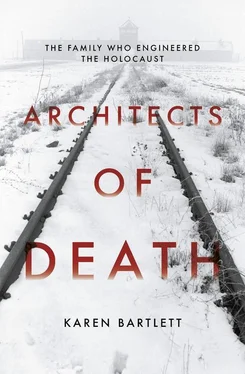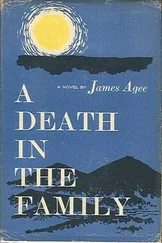Buchenwald inmate, and later historian of the camp, Eugen Kogon wrote:
The choice of the site was symbolic in a higher sense: Weimar, the national centre of German culture, formerly the city of German classical writers who had given German emotion and intellect their highest expression, and Buchenwald, a raw piece of land on which the new German emotion was to flower. Together a sentimentally cultivated museum culture and the unscrupulous, brutal will for power thus created the typical new connection Weimar-Buchenwald. [26] Eugene Kogon quoted in ibid., p. 29.
Plans to build the camp were initiated in May 1936 by Inspector of the Concentration Camps and Chief of the SS Totenkopf Squadrons, Theodor Eicke, and the Reich leader of Thuringia Fritz Sauckel. The chief of the Thuringian police department for the Ministry of the Interior Hellmuth Gommlich, a longstanding Nazi and anti-Semite, was charged with finding the site for the camp and its establishment. After considering several alternatives, Gommlich and Eicke decided on a wooded limestone ridge on the north slope of the Ettersberg – a decision much welcomed by the local farmers, according to a letter from Gommlich to Eicke: ‘At a joint meeting the local farmers’ association submitted a declaration to me to the effect that the establishment of a camp at the site I have proposed meets with their fullest approval. The association urgently requests the realisation of the plan as quickly as possible.’ [27] Ibid., p. 27.
The SS constructed the first barracks on the north side of the camp before the inmates arrived, and on 15 July 1937 the first lorries pulled up with 149 inmates from Sachsenhausen, followed in subsequent weeks by transports from newly closed concentration camps at Sachsenburg near Chemnitz, and Lichtenburg.
Helmut Thiermann described his transport from Sachsenburg on 27 July:
The lorries were covered with tarps and it was only through the noise on the roads and the ventilation flaps in the tarps that we could guess more than witness the course of the journey… when we drove into a densely wooded area [on the far side of Weimar] we knew that we had reached our destination.
Thiermann goes on to describe his first night at Buchenwald:
On the first night we shared the barracks with the SS and the next day we moved to the actual camp, Block 7. Following our arrival we received red cloth triangles and two long canvas strips with numbers which we had to sew to our jackets and trousers in precisely designated places. I received number 318. From now on we were mere numbers and nameless beings. We completed the construction of a partially built barrack, Block 7, and moved into this block the same day.’ [28] Ibid., p. 31.
The red triangle denoted that Thiermann was a political prisoner.
During the 1930s, concentration camps accommodated the victims of the Nazis’ progressively more extreme racial and social persecution. The Nazi vision of a society in which ‘natural simplicity of the German people’ would unite with ‘energy strength and assertiveness’ [29] Ibid., p. 19.
first focused on disabled people – leading to their forced sterilisation ‘for the prevention of genetically ill offspring’ in 1933, and their eventual murder under the Nazi euthanasia programme during the war.
In addition, the Nazis tightened their grip on ‘asocials’, a category of ‘national vermin’ that included convicted criminals and homosexuals. In 1935, increasingly the police began using ‘preventive police detention’ as a way of ‘cleansing’ society. Aimed initially at criminals and gay men, in February 1937, Himmler ordered the rounding up of 2,000 of those who ‘endanger society through their asocial behaviour’. Many of the victims of these mass arrests found themselves transported to the gates of Buchenwald. By December of that year 7,746 people were held as prisoners in Nazi concentration camps.
Five miles of wooded road separate Buchenwald from Weimar, but ‘blood road’, as it was known by the inmates who built it and often died doing so, created a symbiotic connection between the life of town and camp.
‘There existed many everyday connections between Weimar and the camp, from the beginning to the end.’ Michael Kater notes, ‘Many of these were part of a tight administrative, commercial and human-relations network. There was no escape from this.’ [30] Kater, op. cit, p. 256.
Buchenwald became an incorporated part of the town of Weimar on 1 April 1938, six months after the town council had filed an application to bring the two together, expecting it to be a union of great financial benefit. From this point on Buchenwald had a Weimar telephone code, and soon its own suburban post office. Weimar supplied both a water supply, and firefighters responsible for the camp until 1942, as well as convening a special Nazi court in the town when two inmates murdered an SS guard and were subsequently recaptured and executed. A municipal bus service connected the two locations, six times a day for a thirty-minute ride that cost 40 pfennig.
SS officers were a common presence on the streets of Weimar; attending the opera, giving free music recitals in town squares, entering their German Shepherds in dog shows and playing in SS football teams against neighbouring sides. Children of SS officers often attended local schools, and one theatre even offered a special SS subscription rate. In August 1939, the SS organised a huge summer festival in Weimar, on land near the camp, where they laid on sausage stands, coloured balloons, games booths and much singing and dancing. ‘Everywhere something was frying and steaming,’ wrote one happy local participant. ‘Two huge oxen were grilled on spits.’ [31] Ibid., p. 268.
The presence and movements of the SS regiments up at the camp were frequently reported in the local newspapers and ordinary town people often saw the inmates of Buchenwald for themselves; marching past in labour detachments, or employed in local businesses like wholesalers, or in construction teams on prominent sites, including the Hotel Elephant. When the SS feared that potential bombing raids could destroy historic Weimar sites – like Goethe or Schiller’s houses, former craftsmen now incarcerated in the camp were forced to make replicate furniture to be displayed in the houses until the end of the war while the real furniture was safely stored elsewhere.
More than sixty Weimar firms used labour from Buchenwald between 1942 and 1945, and for the duration of its existence more than forty Weimar firms profited from serving and supplying the camp. Nazi Party chapter leader, town councillor and SS officer Thilo Bornschein provided almost all the foodstuffs to the camp, and became rich enough to afford Bauhaus-Muche’s Haus am Horn. His turnover in 1941 alone was half a million Reichsmarks. Hans Kroger, who had taken over the Aryanised Herman Tietz mixed goods department store for the equivalent of less than a penny, operated a near monopoly on textiles, while local butcher Karl Daniel provided sausages (known as rubber sausages due to their appalling quality) and brewery Deinhardt shipped beer to the SS. The historic apothecary in the quaint main town square supplied SS physicians with the drugs they frequently used to kill people.
In total, many local people either serviced the camp, or met its inmates on the road, on a building site, or even in town itself working on a forced labour project. A snapshot photo, taken in 1939, shows a gang of inmates marching down a street in the neighbouring village of Gaberndorf, while a man and a small boy lean against an open door watching curiously, but impassively.
For some local residents, interaction with the camp was even more sinister. Take, for example, the doctors, nurses and administrators in the Weimar municipal hospital that treated both SS officers from the camp, and some camp inmates, up until the summer of 1938. It was in these hospitals that some camp prisoners were brought to be forcibly sterilised. Those physicians were certainly aware of the terrible circumstances in Buchenwald. So, too, was the Weimar office of public health and its employees, who were responsible for setting rations for camp food and for overseeing the response to the typhus epidemic of 1939 that arose due to appalling hygiene conditions.
Читать дальше












